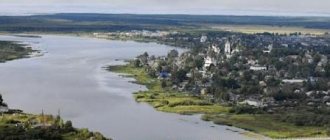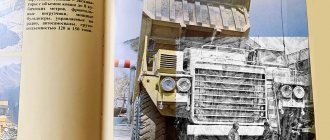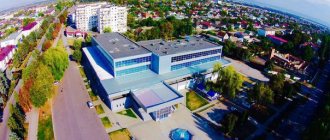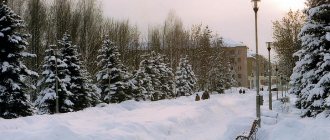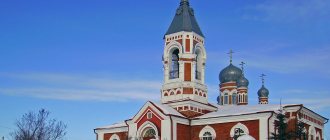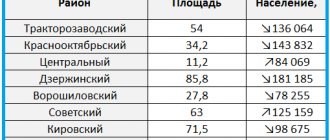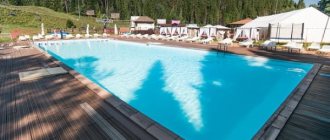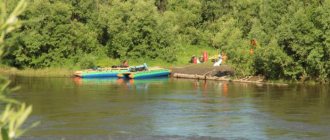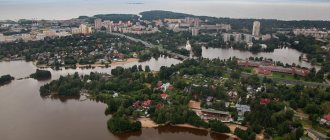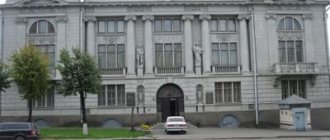Why was the city of brides called that?
Ivanovo received the nickname “city of brides” in the post-war period, as many men died on the fronts of World War II, and many women worked at local textile enterprises. In percentage terms, there were several times more of them than representatives of the stronger sex.
Interesting materials:
Why is Mivina Rollton harmful? What is expressed from right to left in front? What causes global environmental problems? How to seal old socket boxes? How will The Walking Dead comic end? How to tighten the nuts? How to tighten the bolt? How to protect furniture from a cat? How to cover your ears when swimming? How to cover the foam after installing plastic windows?
The Uvod River and its Shuisky tract to the Tinsky transport
The Uvod River is one of the notable tributaries of the Klyazma. I chose a place for my current that was absolutely flat - no slides, no hillocks. Moreover, it spreads across the plain with oxbow branches. Very leisurely. And along the left bank of the Uvod River ran the historical Shuisky tract. There is an opinion that the name of the river Uvod comes from the word “suvod” - whirlpool, others believe that it comes from “by the water”. The river is interesting, we decided to take a look at it.
To begin with, we moved to the left bank of the Klyazma, the Uvod flows in from that side. Over the bridge in Kovrov, through which the modern version of the Shuya tract passes - the Ivanovo-Shuya-Kovrov road. Because of this bridge, the road now goes differently than before. And the previously known Tinsky transport on the Klyazma remained only in stories.
From Zarechnaya Slobodka to “straightening the Uvod River”
View of Klyazma from Zarechnaya Slobodka
For centuries, Zarechnaya Slobodka stood on the opposite bank of the Klyazma from Kovrov. To this day it has retained its rural charm. A green one-story street overlooking the mirror of a calm, wide river. And with cozy gazebos by the water. And on the other side, in the “old town” of Kovrov, the old red brick buildings of the Treumov-Abelman Factory were already looming. They looked textured, as if demanding that some kind of art space be opened in them. The red brick buildings from the 19th century are worth a visit.
Treumov-Abelman Factory
We pass by oak groves. Obviously young and, judging by the rows of trees, man-made. I remembered how they were looking for oak groves around the princely city of Starodub. Much lower downstream of the Klyazma.
Young oak grove
And then we reached the “false” mouth of the Uvodi. Here part of the waters of the Uvodi River flows into the Klyazma. The mouth is not a real one, a canal that unites two rivers. They say it was dug in the 50s of the 20th century by the local state farm “Giant” for the purpose of land reclamation. Local experts once even rafted along this canal in a rubber boat. The channel is wide, straight, deep, why not? We walk along the coast, periodically crossing ditches dug to drain the fields. There is no water in them, so they cannot serve as an obstacle.
Straightening the Uvod River
So we reached the dam at the beginning of the canal. Or, as it is indicated on some maps, “the straightening of the Uvod River.”
Uvod in the city of Ivanovo, ducks and landmark
A little further on, nothing prevented us from seeing the Uvod River itself. Here, near the mouth, it is at its maximum width, more than ten meters. Water flow is almost two dozen cubic meters per second. The Uvod flows smoothly, very leisurely across the plain, entering the Vladimir region. The channel is very winding, with many oxbow lakes. The canal along which we walked was as straight as an arrow compared to the riverbed.
Actually, the Uvod River. Ten kilometers to the mouth
I had a chance to see the Uvod much higher upstream - in the city of Ivanovo. This, by the way, is the main river of this regional center. They say that during the old textile factories of the 19th century, Uvod within the city of Ivanovo was dirty and smelly. But those factories either closed or mastered more modern technology, and now under the Theater Bridge Uvod pleases with flocks of ducks. People come to feed them - a local city attraction. Above the city on the river there is the Uvodsky reservoir, reaching one and a half kilometers wide and 37 kilometers long. After Ivanovo-Voznesensk (as it was previously called), the river flows through the city of Kokhma.
Ducks on the Uvod River in Ivanovo
The total length of the Uvod River reaches 185 kilometers. It originates in the Andreevsky swamps near the regional center of Komsomolsk in the north-west of the Ivanovo region.
The Shuya tract ran along the right bank of the Uvod River through Shuya to Klyazma. Considering the direction of the road to the city of Kovrov, one of the main streets of Shuya was even called Kovrovskaya for a long time. Near the city of Ivanovo, the Shuisky tract connected with Arakcheevsky and there are even clearings - the remains of that famous road. Arakcheevsky tract, therefore the shortest route from St. Petersburg to Siberia and convicts were driven along it.
The Shuisky tract is beyond the Uvodya, and the fishermen are at the dam
Not far from the beginning of the canal dug by the “Giant” there was the old village of Bolshie Vsegodichi. The Shuisky tract passed behind it. From the dam, where the “straightening” began, the Assumption Church with its magnificent hipped bell tower was clearly visible in that village. It dominated the horizon of the surrounding plain, rising between the trees along the banks of the Uvod River. Someday we'll take a closer look at it.
Place in front of the dam where fishermen gather
In front of the dam there is a crowd of fishermen with fishing rods. I thought, this is a fishing place, we should somehow end up here ourselves with a fishing rod. Moreover, in Kovrov public pages, fishermen speak only positively about Uvodi. Yes, the whole “straightening” duct is chosen by them. By Saturday evening, the roofs of parked cars can be seen here and there among the bushes. People used local roads to get to Uvod for fishing.
Canal from the Uvod River to Klyazma
Fishermen also approached the spot from which they admired the mirror of the channel. Having wished them perches with “those eyes” and everything else of the appropriate size, we set off.
The real mouth of the Uvodi and the disappeared Tinsky transport
The Shuisky tract faithfully reached along the bank of the Uvodi River to the Klyazma River. He crossed the Klyazma at a place known as the Tinsky Perevoz. And then it continued on the other - the right bank of this large river.
We are looking for a continuation of the Shuisky tract
We walked conscientiously along the right bank of the Klyazma, trying to find the continuation of the Shuya tract. We went to the Tinsky transportation through our beloved Shirina Gora. Old roads passed here too. In ancient times, the robber Shirin hunted there, after whom the mountain was named.
We could not determine the clearing where exactly the Shuisky tract passed on the right bank of the Klyazma. Too much has changed here over the past decades. Among the clearings maintained by forestry departments or for communication lines, you can get confused. I think if an expert in local history had been with us, he would have found the continuation of the road unmistakably.
An expert would tell me if the old road passed here
But there is an exact landmark - the Tinsky transport itself. We observe the mouth of the Uvodi on the other side. You can see how narrow the Klyazma is; the weight categories of these rivers are incomparable. Moreover, some of its waters flow into the Klyazma earlier. Through the same canal “straightening the Uvodi River”, going straight to Kovrov.
The real mouth. The Uvod flows into the Klyazma
Why Tinsky transport through Klyazma Tinsky and here
A little lower from the present mouth of the Uvod River near the present village of Glebovo, on the Kovrov-Mstera road there once was a Tinsky transport. Crossing on the path of the historical Shuisky tract.
There used to be a Tinsky transport here
Why did the transportation end up here? The road kept to the left bank of the Uvodi, so as not to establish a crossing over this river as well. When the two rivers connected, the road finally ran into Klyazma, which was impossible to bypass. We had to cross this water barrier.
Klyazma near Tinsky transportation
There was no bridge here. Transportation by ferry existed back in the 60s of the 20th century. The writer Vladimir Soloukhin managed to use it and mentioned it in his book “Vladimir Country Roads”.
The end of the Tinsky transportation was the construction of a road bridge across the Klyazma near Kovrov. The current successor to the Shuisky tract, the Ivanovo-Kovrov road, made a detour to the bridge. Where the sharp turn “happened,” the clearing still continues straight ahead and there is a dirt road leading to the river. It approaches the left bank, where there was once a transport and ends in nothing. On the right bank of the Klyazma, practically nothing reminds of transportation. Only a couple of places convenient for mooring boats.
There is an opinion that the village of Tina was here - algae. But it burned down along with nearby Starodub during hard times and left only the name of the transport. And now there is no crossing.
After a semi-successful search for the Shuisky tract
We sat on the left bank of the Klyazma, opposite the Transfiguration Cathedral and admired the panorama of Kovrov. Its buildings and temples were reflected in the mirror of the water. We enjoyed the silence interrupted by the ringing of bells.
Spaso-Preobrazhensky Cathedral on the other side
The warm setting sun warmed my back. Beauty and peace. Here on the Klyazma between the Nerekhta and Uvod rivers 242 years ago Kovrov received the status of a city.
Oleg Vinokurov,
photo: Dmitry Vinokurov
In the middle of the 19th century, archaeologists discovered several mounds and burial grounds that had stood since ancient times on Yamy, that is, in the area of Kalinin Street (city center, left bank of the Uvod River). Scientists suggest that the territory of Ivanovo was inhabited by Finno-Ugric tribes 1000 years ago, but later the Slavs settled the area.
Uvod River Uvod is a river in the Ivanovo and Vladimir regions, the second largest tributary of the Klyazma after the Nerl (length 185 kilometers), originates northeast of the city of Komsomolsk in the Andreevsky swamps.
It flows into the Klyazma through two channels: two kilometers north of Kovrov and eight kilometers northeast of it. The drainage basin area is 3770 square meters. km. In 1937, to the north of Ivanovo on Uvodi, a large Uvod reservoir was created. Its length is 37 kilometers, width is up to 1.5 kilometers. The reservoir was created to supply water to the city of Ivanovo, and is replenished with Volga water through the Volga-Uvod canal. Construction of the canal began in September 1960. In September 1966 it was put into operation. The pumping station raised water from the Volga to a height of 51 m, and then it flowed by gravity. The length of the canal was 78 kilometers. Two more dams were built within the boundaries of Ivanov itself, which made it possible to build embankments and organize the movement of small pleasure boats on Uvodi. Having received two large tributaries on the right - the Ukhtom and the Vyazma, the Uvod expands and begins to form numerous oxbow lakes, channels and islands, among which the extremely winding main channel is often lost. In some places, Uvod forms lake-like extensions. The river retains this character right up to its mouth. In the 19th century, the Uvod became one of the dirtiest rivers in Russia. Here is what they wrote about the state of the river within Ivanovo-Voznesensk at the turn of the 19th and 20th centuries: “Its water, alternately colored red, green, or blue and covered with a rainbow film of oil, emits a suffocating stench that spreads in the summer heat for several miles. Everything is dumped into the river: waste paints, oil residues, sewage. Old people still remember how this river was home to fish, crayfish, and was a wonderful watering hole. Now it's a river of death. There is absolutely no organic life in it. Even on its banks, grass, sedge and small bushes stand as if scorched.” The first mention of a settlement on the Uvod River in this area dates back to 1328.
In Ivan Kalita’s spiritual document it is called “the settlement of Ivan on Uvodi.” In the middle of the 14th century, during the time of Dmitry Donskoy, the settlement was named the village of Ivan. Presumably, during this period, a chapel in honor of John the Baptist appeared in the village of Ivan, which served as the basis for naming the village after this saint. After the construction of the Church of St. John the Baptist, the settlement acquired the status of a village. At the beginning of the 15th century, under the Grand Duke Vasily the Dark, Ivanovo was already called a village. Later mentions of the village of Ivanovo in chronicles occur in 1561. This year, according to legend, it was transferred by Tsar Ivan IV the Terrible to the princes of Cherkassy, after his marriage to Maria Cherkassy, but the document on the donation of the village has not been preserved. In 1579, the Pokrovsky monastery for men was built near the village, and next to it the monastery settlement of Pritykino. At the end of the 16th and beginning of the 17th centuries, the villages of Ivanovo and Kokhma, which were part of the Kokhomskaya volost, were the patrimony of the Skopins-Shuiskys. Acts of the late 1610s - early 1630s record the villages of Ivanovo and Kokhma in the possession of princesses Anna Petrovna and Alexandra Vasilievna Skopin-Shuisky, mother and wife of Mikhail Vasilyevich Skopin-Shuisky. According to the will of the “elder princess Anisya Petrovna” Skopina, Ivanovo and its villages went to Ivan Ivanovich Pugovka-Shuisky, the last representative of the Shuisky family. In the first half of the 17th century, Ivanovo was briefly in the possession of the Shuisky princes, after which it returned to the Cherkassky princes. From the description of the village in 1667 it was clear that it was getting richer and growing. In 1742, the first linen manufactory appeared in the village, owned by the peasant Butrimov. Soon a large finishing manufactory, Sokov, appeared, located near the Uvod River. In 1743, the village of Ivanovo came into the possession of Count Sheremetev. At the beginning of the 19th century, foreign steam engines began to appear in factories, after which the first spinning mill opened. The village of Ivanovo in 1844. In 1853, several settlements united into Voznesensky Posad
, which arose on the site of the village of Ikonnikovo, which until 1612 belonged to the ancestor of Alexander Pushkin.
Voznesensky Posad was socially more developed in contrast to Ivanov. This difference prevented the rapid merging of settlements. Voznesensky Posad in 1861. After the Reform of 1861, industry developed in terms of organizing production. Thanks to this, production volumes increased, despite the fact that no new enterprises were built until 1890. The first hospital
appeared in Voznesensky Posad in 1861. Many Ivanovo entrepreneurs collected money for the construction of the hospital. In 1865, the first Ivanovo public library opened.
On July 21, 1871, Emperor Alexander II approved the renaming of the village of Ivanovo and Voznesensky Posad of the Vladimir province into the district-free city of Ivanovo-Voznesensk,
.
Thus, the old flax processing center, the village of Ivanovo, merged with the industrial Voznesensky Posad and received the status of a single administrative unit. Opening of the city of Ivanovo-Voznesensk and the Cathedral Church there on August 30, 1873. Yakov Petrovich Garelin
, a philanthropist, local historian, industrialist and public figure, is considered the founder of the city of Ivanovo-Voznesensk and the first Head of the city. Under his leadership, large-scale improvement of the city and greening of streets began. On May 30, 2011, in honor of the 140th anniversary of the city of Ivanovo-Voznesensk, a monument to Yakov Garelin (sculptor I.V. Bychkov, architect V.M. Shakhmatov) was unveiled on Revolution Square. See the opening of the city of Ivanovo-Voznesensk and the Cathedral Church in it.
Monument to Yakov Garelin
Ivanovo has traditionally been a center of light industry (for the title of the main center of light industry in Europe, the city competed with the Polish city of Lodz, which was also part of the Empire at that time). Here, at one of the textile factories, a steam engine first appeared. On April 30th of this 1895 in the city. In Ivanovo-Voznesensk, a solemn prayer service was held on the trading square on the occasion of the agreement between all traders to reduce trading hours on all Sundays and holidays. The city of Ivanovo in 1900. January 17, 1901 - opening of visiting sessions of the Vladimir District Court in the city of Ivanovo-Voznesensk. In the first decade of the 20th century, weavers and other workers were dissatisfied with their living and working conditions, resulting in frequent strikes by the local proletariat. During the First Russian Revolution, the Ivanovo-Voznesensk City Council of Workers' Deputies was created in the city, which was the first in Russia (hence the name "Motherland of the First Council"). On May 12, 1905, a 72-day general strike of Ivanovo-Voznesensk workers began, which was organized by revolutionaries A. S. Bubnov (Khimik), N. N. Kolotilov (Lapa), N. I. Podvoisky (Mironych), M. V. Frunze (Arseny).
Monument to the fighters of the 1905 revolution on Revolution Square
Memorial "Red Talka"
On June 20, 1918, the city of Ivanovo-Voznesensk received high administrative status, becoming the center of the province. In the same year, the first universities appeared in the city. Mikhail Vasilyevich Frunze became the first chairman of the Ivanovo-Voznesensk provincial committee of the RCP (b), the provincial executive committee and the provincial economic council. In 1925, an aviation detachment was formed in Ivanovo-Voznesensk, on the basis of the 3rd Rifle Corps. It is from this moment that Ivanovo aviation traces its history. The new military unit was named the 3rd Separate Aviation Detachment named after Ivanovo Workers. Initially, the squadron was equipped with German Junkers 21 aircraft, produced under license in the USSR. It was based at the Yuzhny airfield, on the site of which Tashkentskaya, Lezhnevskaya, Poletnye and 3rd air squad streets are now located. From 1927 to 1934, the air detachment was commanded by the future air marshal Stepan Krasovsky. On November 14, 1929, a decision was made to form the Ivanovo Industrial Region [9] (IPO), which united the pre-revolutionary Vladimir, Kostroma and Yaroslavl provinces. The region was inhabited by about 5 million people. In terms of the value of manufactured products, IPO ranked third in the country. 49% of the all-Union production of cotton fabrics and 77% of linen fabrics were concentrated here. There were 65 cities and towns in the region, including such large industrial centers as Ivanovo-Voznesensk, Yaroslavl, Vladimir, Kostroma, Rybinsk, and Kovrov. After Moscow and Leningrad, Ivanovo-Voznesensk was considered the “third proletarian capital” of the USSR.
Design of the coat of arms of Ivanovo-Voznesensk
Project of the coat of arms of Ivanovo-Voznesensk 1873 Project of the coat of arms of Ivanovo-Voznesensk 1918
The reference book by A.V. Kudin and A.L. Tsekhanovich “Coats of arms of cities and regions of the Russian Empire 1900-1917” shows the coat of arms of Ivanovo-Voznesensk. Description: In the upper part is the coat of arms of the Vladimir province, in the lower azure field there is a wheel, a retort, an anchor and bales of gold yarn. However, this coat of arms was not approved, and Ivanovo-Voznesensk continued to remain without the main symbol.
Coat of arms of Ivanov during Soviet times
Approved by the City Executive Committee on May 8, 1970 for the centenary of the regional center. Designed by Leningrad artist Vitaly Petrovich Kubashevsky. Compared to other, new coats of arms of that time, overloaded with typical Soviet symbols - stars, gears, ears of corn, sickles and hammers, the coat of arms looked more modest, laconic and complied with the rules of heraldry. Elements of the 1970 coat of arms formed the basis of the modern coat of arms of the Ivanovo region. Description: On the blue background on the left is a torch - a symbol of the struggle of Ivanovo-Voznesensk workers during the years of the first Russian revolution, a symbol of the city - the Motherland of the First Council; on the right, on the black lines representing the warp threads, is a weaving shuttle, characterizing Ivanovo as a cultural center of the textile industry; below is a white winding line, a symbolic image of the Talka River.
Modern coat of arms
Approved by the Ivanovo City Duma of the first convocation on May 22, 1996. Description: In an azure (blue, blue) field - a young woman in a silver shirt with a gold collar and a scarlet (red) sundress, decorated with gold at the top, with a scarlet kokoshnik, decorated with gold, and a silver scarf on her head, sitting and facing to the right, behind her knees appears a golden comb of a spinning wheel with a silver tow standing behind her, which she holds with her right hand; in front of her stands a spinning wheel, the wheel of which she rotates with her left hand.
Ivanovo Metropolis
Metropolitan Joseph of Ivanovo-Voznesensk and Vichuga. By the decision of the Holy Synod of the Russian Orthodox Church on June 7, 2012, he was appointed head of the newly formed Ivanovo Metropolis. On July 18, 2012, His Holiness Patriarch Kirill of Moscow and All Rus' elevated him to the rank of metropolitan. In 2012, the Ivanovo Metropolis was formed within the Ivanovo region, which includes the Ivanovo-Voznesensk, Kineshma and Shui dioceses. The metropolis has 185 parishes and 12 monasteries (7 male and 5 female), 244 parish and 85 monastery churches. There are also 25 house churches, 59 chapels, and 11 houses of prayer in the diocese. The metropolis includes 8 educational institutions, including: St. Alekseevskaya Ivanovo-Voznesenskaya Orthodox Theological Seminary, Ivanovo Orthodox Theological Institute of the Holy Apostle John the Theologian, 6 Orthodox secondary schools and gymnasiums. Cathedral of Ivanovo Saints.
Monasteries of the city of Ivanovo
By the decision of the Holy Synod of March 13, 2002, in accordance with the historical name of the diocese, it was named Ivanovo-Voznesenskaya. The diocesan bishop of the Ivanovo-Voznesensk diocese has the title “Ivanovo-Voznesensk and Vichuga”. Pokrovsky Monastery. Ivanovo Holy Vvedensky Convent. — Vvedenskaya Church. Spartak street, 23 Ivanovo Holy Dormition Monastery. — Assumption Cemetery Church (brick). Smirnova Street, 76 (Ioann Alekseevich Orlov - Archpriest of the Assumption Church)
Temples of the city of Ivanovo
— Transfiguration Cathedral. st. Kolotilova, 44 - Church of the Edinoverie Annunciation (not preserved). — Temple of the Holy Apostle and Evangelist John the Theologian. Kokhomskoye Highway, 29 – Temple of the Holy Prophet Elijah. st. Koltsova, 19/1 - Temple of the Icon of the Mother of God “Burning Bush” at the Ivanovo Institute of the State Fire Service of the Ministry of Emergency Situations of Russia. ave. Stroiteley, 33 - House church of the Feodorovskaya Icon of the Mother of God in the Orthodox boarding school in honor of the Feodorovskaya Icon of the Mother of God and the Naval Cadet Corps. Admiral G. Nevelsky. st. Pavlova, 15/26 - Church of the Holy Apostles Peter and Paul cemetery in the town of Balino. st. Selskaya, 1 - Church of the Presentation of the Vladimir Icon of the Mother of God. st. Lezhnevskaya, 118a - Temple of the Kazan Icon of the Mother of God. Sheremetyevsky Ave., 41 – Church of the Icon of the Mother of God “Blessed Heaven” in the “Northern” garrison. — Temple of St. Seraphim of Sarov. st. General Khlebnikov, 32 A - Temple in honor of the Intercession of the Mother of God. st. General Khlebnikov, 32 A - Church of the Holy Trinity. st. Pochtovaya, 6 - Spasskaya Church, which is located at the Real School - the Cathedral of the All-Merciful Savior (not preserved). — Church of St. Nicholas the Wonderworker of Myra at the regional clinical hospital. st. Lyubimova, 1 - Temple of the Icon of the Mother of God “Healer” at the 1st city hospital. st. Paris Commune, 5, bldg. No. 1 - Temple of the Icon of the Mother of God “Inexhaustible Chalice” at the regional drug treatment clinic. st. Kuznetsova, 106/1 - House church of the icon of the Mother of God “Helper in Childbirth” at maternity hospital No. 1. st. Leningradskaya, 3/16 - Home church of the great martyr and healer Panteleimon at the Ivanovo regional psychoneurological boarding school and the Intercession of the Mother of God. st. Blagova, 38 - Temple of the Icon of the Mother of God “Inexhaustible Chalice” at the Regional Dermatovenerological Dispensary. st. Children's, 2/7 - Temple of the Archangel Michael at the professional lyceum of the Ivanovo State University of Architecture and Civil Engineering. st. Professional - Church of St. Alexy, Metropolitan of Moscow, at the St. Alexeevsk Ivanovo-Voznesensk Orthodox Theological Seminary. st. Maria Ryabinina, house 29 - Church of the Cathedral of Ivanovo Saints at the St. Alekseevskaya Ivanovo-Voznesensk Orthodox Theological Seminary. st. Maria Ryabinina, building 29 - Temple of the Cathedral of Ivanovo Saints (Student Orthodox Church of All Saints). Posadsky Lane, 8B - Temple of the Icon of the Mother of God “Addition of Mind” on the street. Kalinina near school No. 1. - Church of the Icon of the Mother of God "Burning Bush" at fire station No. 1. Sovetskaya, 26 - Church of the Icon of the Mother of God "Joy of All Who Sorrow." intersection of the street Kuznetsov and Rabfakovskaya - Prayer room - chapel of St. Sergius of Radonezh and the Holy Blessed Prince Demetrius Donskoy. st. Sarmentova, 7 - Parish of the Edinoverie Old Rite Church of the Kazan Icon of the Mother of God (wooden cemetery). st. Frunze, 7 - Church of the Holy Martyr John the Warrior (under construction) in Avdotino. st. Revolutionary - Church of St. George the Victorious and the Icon of the Mother of God “Seeking the Lost.” "square of victory".
Chapels
— Chapel of the Bogolyubskaya Icon of the Mother of God. st. 1st Polyanskaya, 30 - Chapel of the Holy Blessed Prince Alexander Nevsky. Sheremetyevsky Ave., 11 - Chapel of the Icon of the Mother of God “Hodegetria”. Kokhomskoye Highway, 2 - Chapel-temple in honor of the Feodorovskaya Icon of the Blessed Virgin Mary. Revolution Square - Trinity Chapel in the lower bazaar. the beginning of Krasnogvardeyskaya Street is the Kazan Chapel. intersection of Smirnova and Lezhnevskaya streets - Vladimir Chapel in Ikonnikov. corner of 8 March and Kalinina streets. The site of the Civil Engineering Institute is the New Kazan Chapel. corner of Lenin Avenue and Pochtovaya Street, territory of the Main Post Office - Chapel "Bogolyubovsky Column". Postysheva street - Transfiguration Chapel in Rylikha. Suvorov Street - Chapel in Glinishchev. street 3rd line - Chapel in Kuryanov. Old Kuryanovo - Chapel of the Origin of the Honest Trees of the Holy Cross (under construction) at City Hospital No. 2 on the street. Ermaka - Chapel of the Icon of the Mother of God “Unfading Color” at the city hospital No. 8. st. Machine Tool Builders, 4
Monasteries of the Ivanovo region
In 2012, the Shuya diocese, separated from the Ivanovo-Voznesensk diocese, was formed within the administrative boundaries of the Gavrilo-Posad, Ilyinsky, Komsomolsky, Lezhnevsky, Savinsky, Teykovsky, Shuisky and Yuzhsky districts of the Ivanovo region. The diocesan bishop of the Shui diocese has the title “Shuisky and Teikovsky”. Shuya diocese. Spassky Convent. Shuya Trinity Shuya Monastery, Shuya Shuya-All Saints Edinoverie women's monastery. Shuya Resurrection-Fedorov Monastery. Shuisky district, Sergeevo Holy Assumption Convent. Shuisky district, Dunilovo Nikolo-Shartomsky monastery. Shuisky district, Introduction In 2012, the Kineshma diocese, separated from the Ivanovo-Voznesensk diocese, was formed within the administrative boundaries of the Verkhnelandekhovo, Zavolzhsky, Kineshma, Lukhsky, Palekhsky, Pestyakovsky, Puchezhsky, Rodnikovsky and Yuryevetsk districts of the Ivanovo region. The diocesan bishop of the Kineshma diocese has the title “Kineshma and Palekh”. Kineshma diocese. Assumption Convent. Kineshma Makariev Reshem Convent. With. Reshma, Kineshma district St. Nicholas Tikhonov Lukhsky monastery. With. Lukh Nikolsky Monastery. Pischugovskaya men's desert. Komsomolsky district, village. Pischugovo Nikolsky Convent. Lezhnevsky district, village. Lezhnevo Znamensky Convent. Lezhnevsky district, village. Lezhnevo Spaso-Kukotsky Monastery. Gavrilovo-Posadsky district, village. Serbilovo. Pokrovsky nunnery Kukotsky monastery. Gavrilovo-Posadsky district, village. Serbilovo. Monastery of the Life-Giving Cross of the Lord. With. Antushkovo, Ilyinsky district, Borkovskaya Trinity-Nikolaevskaya hermitage. Yuzhsky district, Borok Holy Resurrection men's Ermolinsk hermitage. With. Ermolino, Furmanovsky district Zolotnikovskaya Assumption hermitage. Teykovsky district, village of Zolotnikovskaya Pustyn Svyatoezersky Iversky Monastery. village Mugreevsky, Yuzhsky district St. Nicholas Convent. Privolzhsk Spaso-Preobrazhensky Monastery. Plyos
Copyright © 2016 Unconditional love
